COLOSSIANS REMIXED: SUBVERTING THE EMPIRE
Written by Brian J. Walsh and Sylvia C. Keesmaat Reviewed By Timothy GombisThe authors of the present volume, a husband and wife team from Canada, have presented a powerful reading of Colossians that brings together and benefits from a number of areas of inquiry. The most dominant influence in this work, quite obviously, is recent work in biblical studies having to do with potential anti-imperial polemics embedded in Paul’s letters. In addition to being conversant with this ‘fresh perspective’ on Paul, they demonstrate great skill in cultural analysis, bringing the reader a well-informed, subtle, and easily-digested discussion of the postmodern situation. Their aim is to hear Colossians faithfully within an imperial context in the first century so that the letter can be heard fruitfully in contemporary postmodern situations. Although this is a very wide-ranging book, covering several discussions in biblical studies and cultural analysis, it is quite coherent, hangs together well, and is extremely compelling.
Walsh and Keesmaat employ a variety of styles successfully, keeping the journey through some fairly complicated terrain from ever becoming a slog. The authors carry on a conversation with their reader throughout the book, anticipating very well the kind of objections and problems readers may have with their proposal. After a lengthy ‘targum’ on Colossians 1:1–14, their imagined reader interrupts with, ‘What was that?’ This, of course, gives them an opportunity to explain just what they have done in composing a number of targums throughout the book, and how such works have functioned to bring the Word of God to bear on situations facing the people of God. They also introduce the reader to three characters who have been affected by the postmodern situation in various ways: William, a student who bristles at talk of absolutes; Eric, who epitomises the postmodern incredulity toward all metanarratives; and Elanna, in whom postmodernism has bred a complete paralysis about making any decisions whatsoever. The authors’ on-going conversation with these three people keep the discussion from ever being merely ‘academic’.
One feature that Walsh and Keesmaat could have exploited to greater effect is their fictional reconstruction of the situation involving Nympha, a women who is mentioned in Colossians 4:15. She is introduced in the book’s third chapter with an autobiographical account of her conversion, but this isn’t picked up again until much later in the book, with an imagined letter from Onesimus to Paul, reporting on how the letter we know as Colossians was received by the community(ies) in the Lycus Valley. But this surely is mere quibbling. This feature again effectively served to bring to life the conflicts and tensions faced by those seeking to be faithful to Jesus in an imperial situation. That Walsh and Keesmaat leave the reader asking for more is a sign that they have hit their mark.
Their book provides a fresh and invigorating reading of Colossians and serves as an excellent model for clearing space and giving place for the Scriptures to speak with power in contemporary settings. It is a must-read for students of Paul and for those seeking to walk in the way of the Lord in this postmodern world.
Timothy Gombis
Cedarville University







